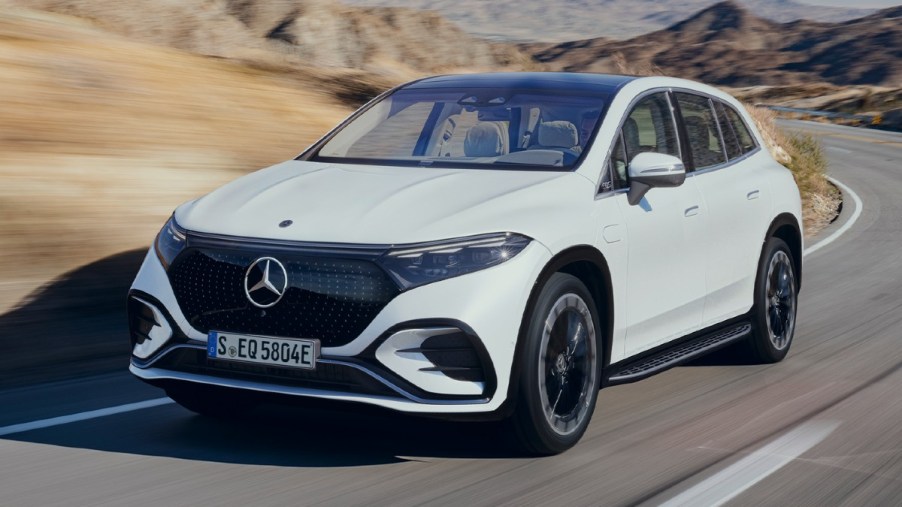
A Guide to Electric Vehicle Range
Switching to an electric vehicle from a gas-powered model can be nerve-wracking. With new EV technology releasing all the time, we’re sure you have many questions. One massive looming thought in everyone’s mind is how far they can drive without recharging. That’s why we’ve compiled a guide to electric vehicle range, answering all your questions from charging to road trips.
Electric car range: Short, long, everything in-between

You’re likely familiar with EPA-estimated fuel economy in gas-powered cars. Those exact estimates exist for electric vehicles; only they can’t give us miles per gallon since there are no gallons. However, we do have the driving range or the distance an EV can drive on a single charge. According to KBB, gas-powered models often exceed their mpg estimates, but EVs usually fall short of theirs.
Long and short-range EVs perform very well in start-and-stop driving situations. If you frequently sit in traffic or take a route with many stoplights, you’ll likely see excellent range performance from an electric vehicle. Moreover, this is because of regenerative braking. This technology extends range by recapturing energy when decelerating using its electric motor instead of the brakes. Furthermore, owners traveling on a long-range highway without many stoppages will receive a shorter overall driving range.
Are EVs good for long trips?

KBB says this shouldn’t deter potential buyers, as EVs are more than capable of making a road trip. For example, one of the most extended range EVs, the 2022 Tesla Model S, can drive 400 miles on a single charge. That’s significantly longer than one of the shortest electric models, the Nissan Leaf S, which can travel about 150 miles without recharging. Does that mean only long-range models are suitable for road trips?
In short, the Nissan Leaf will be a better option for mostly commuting and in-town driving. However, it’s still possible to use it for a long road trip. Electric vehicle manufacturers are making it easier to plan a route ahead of time by the day. All you need to know is a few locations to charge the battery along the way.
According to the U.S. Department of Energy’s Alternative Fuels Data Center, the number of public charging stations nationwide increased by 58% from 2020 to 2021. However, they remain less common than gas pumps. There are about 50,054 stations and 128,474 charging outlets across the country. These numbers are going to grow exponentially as more automakers develop EVs. Since new ones are released every year, we’ll get more automaker-owned stations, more third-party options, and more overall availability.
Charging an electric vehicle is easy
When researching electric models, you’ll likely run into some terms that could be unfamiliar to you. For instance, kilowatt-hours (kWh) and kilowatts (kW) are similar to gas tank size and horsepower. The size of the battery is measured in kWh, and the engine’s power output capability is listed in kW.
Moreover, charging an EV can be done in several different places. One of those places is in the comfort of your own home. Most of the time, you do not need a particular station inside your garage or a specific type of wall outlet. However, charging your vehicle in a standard home outlet will take much longer than at a DC fast-charging station. On the bright side, charging it overnight is as easy as plugging it in and forgetting about it, and your EV will be ready in the morning.
There are three different levels of charging available to electric vehicle owners.
- Level 1 charging is the slowest and uses a standard 120-volt outlet as you have in your home. Using Level 1 charging, most EVs gain about five miles per hour of charging.
- Level 2 charging uses a 240-volt electric circuit, often used for large appliances in your home. Electric dryers, water heaters, and ovens require a 240-volt outlet. Installing one of these in a convenient place to charge your vehicle isn’t expensive but boosts charging capability by a lot. Most EVs gain about 35 miles per hour of charging using Level 2.
- Level 3 is the fastest charging station available and quickly supplies a tremendous amount of power. Modern EVs can gain around 80% capacity in approximately 30 minutes. These chargers are few and far between and only available at public stations. Using DC fast-charging too often is known to weaken your car’s battery over time, though it’s OK every once in a while.
Which EVs have the longest range?

If you’re looking to avoid stopping at charging stations, you’ll need the EVs with the longest range. Some electric vehicles are built to drive long distances without stopping. According to Auto Express, the longest range model of 2022 is the Mercedes-Benz EQS, which has a maximum range of 485 miles. That’s a bit better than the second-place option, the Mercedes EQE, which drops to 410 miles. The Tesla Model S mentioned earlier is in third place, which averages 400 miles per charge.
Driving any of these EVs will almost always help you reach your destination without stopping. Unfortunately, the extended-range batteries are still costly, as are the vehicles housing them. Hopefully, we’ll see a drop in price for long-range electric cars soon.
Electric vehicle range guide
In conclusion, electric vehicles can drive just as far as gas-powered ones with a single charge. Thanks to regenerative braking, many drive further and perform immaculately in stop-and-go traffic. Finding a charging station is easy right now and will only get easier. Stop worrying about how far an EV will make it because the answer is most likely further than you’ve ever gotten without stopping for gas. That’s our guide to electric vehicle range.



